Cuesta College, San Luis Obispo, CA
[Version 1]
[20 points.] Star A has an apparent magnitude m = –1.0, and star B has an apparent magnitude m = +1.0. Discuss how stars A and B are located from Earth, if they have the same absolute visual magnitude M_V = +1.0. Explain using the relationships between apparent magnitude, absolute magnitude, and distance.
Solution and grading rubric:
- p = 20/20:
Correct. Distinguishes apparent magnitude (brightness as seen at actual distance from Earth) from absolute magnitude (brightness as seen from 10 pcs away from Earth). Both stars have the same absolute magnitude, while star B has the same apparent and absolute magnitude, meaning that it is located exactly 10 pcs away from Earth. Star A has an apparent magnitude brighter than its absolute magnitude (as well as brighter than star B's apparent magnitude), thus star A is located closer than 10 pcs from Earth. - r = 16/20:
Nearly correct (explanation weak, unclear or only nearly complete); includes extraneous/tangential information; or has minor errors. As (p), with star A closer than star B, but does not explicitly place star B 10 pcs from Earth. - t = 12/20:
Contains right ideas, but discussion is unclear/incomplete or contains major errors. As (p), but with star B farther than star A, typically due to misinterpreting -1.0 as being dimmer than +1.0, or with star B explicitly placed at 10 pcs away from Earth. - v = 8/20:
Limited relevant discussion of supporting evidence of at least some merit, but in an inconsistent or unclear manner. At least understands distinction between apparent and absolute magnitudes, and/or that star A has a brighter apparent magnitude than its absolute magnitude. - x = 4/20:
Implementation/application of ideas, but credit given for effort rather than merit. - y = 2/20:
Irrelevant discussion/effectively blank. - z = 0/20:
Blank.
Section 30674
p: 18 students
r: 12 students
t: 6 students
v: 4 students
x: 0 students
y: 0 students
z: 0 students
A sample "p" response (from student 1802):
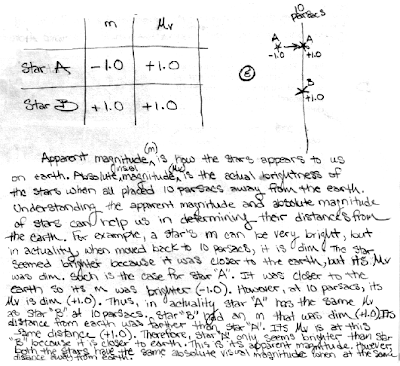
Another sample "p" response (from student 2615):
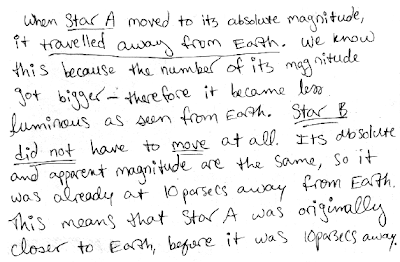
Yet another sample "p" response (from student 5239):
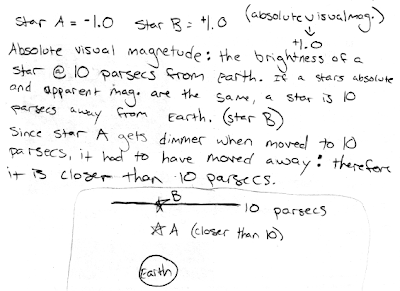
A sample "t" response (from student 1984):
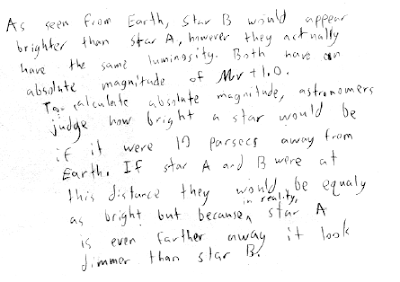
[Version 2]
[20 points.] Star A has an absolute visual magnitude M_V = –1.0, and star B has an absolute visual magnitude M_V = +1.0. Discuss how stars A and B are located from Earth, if they have the same apparent magnitude m = +1.0. Explain using the relationships between apparent magnitude, absolute magnitude, and distance.
Solution and grading rubric:
- p = 20/20:
Correct. Distinguishes apparent magnitude (brightness as seen at actual distance from Earth) from absolute magnitude (brightness as seen from 10 pcs away from Earth). Both stars have the same apparent magnitude, while star B has the same apparent and absolute magnitude, meaning that it is located exactly 10 pcs away from Earth. Star A has an absolute visual magnitude brighter than its apparent magnitude (as well as brighter than star B's absolute visual magnitude magnitude), thus star A is located farther than 10 pcs from Earth. - r = 16/20:
Nearly correct (explanation weak, unclear or only nearly complete); includes extraneous/tangential information; or has minor errors. As (p), with star A farther than star B, but does not explicitly place star B 10 pcs from Earth. - t = 12/20:
Contains right ideas, but discussion is unclear/incomplete or contains major errors. As (p), but with star A closer than star B, typically due to misinterpreting -1.0 as being dimmer than +1.0, or with star B explicitly placed at 10 pcs away from Earth. - v = 8/20:
Limited relevant discussion of supporting evidence of at least some merit, but in an inconsistent or unclear manner. At least understands distinction between apparent and absolute magnitudes, and/or that star A has a brighter apparent magnitude than its absolute magnitude. - x = 4/20:
Implementation/application of ideas, but credit given for effort rather than merit. - y = 2/20:
Irrelevant discussion/effectively blank. - z = 0/20:
Blank.
Section 30676
p: 12 students
r: 13 students
t: 10 students
v: 11 students
x: 21 students
y: 1 student
z: 0 students
A sample "p" response (from student 1337):
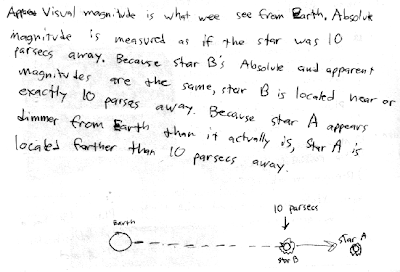
Another sample "p" response (from student 8065):
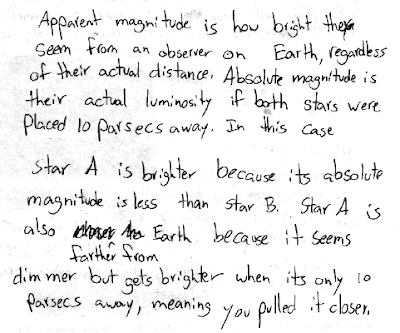
A sample "t" response (from student 1105), with star A being correctly placed more than 10 parsecs away from Earth, but star B being placed closer than 10 parsecs away from Earth, despite having absolute visual magnitude and apparent magnitude values:
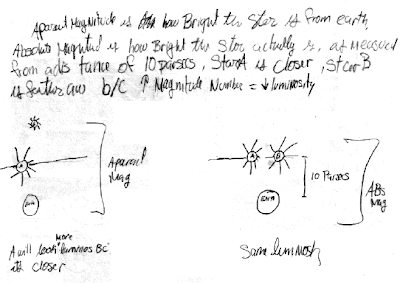
A sample "v" response (from student 1559):

A sample "x" response (from student 4337), with M_V = -1 and M_V = +1 being equally spaced on either side of M_V on a number line:
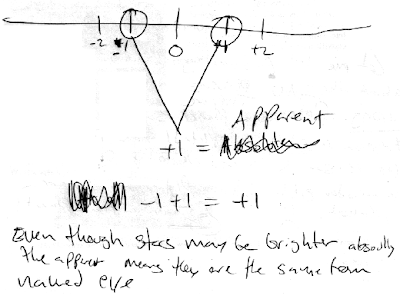
Another sample "x" response (from student 5221), with star A (M_V = -1) and star B (M_V = +1) being equally distant on either side of Earth:
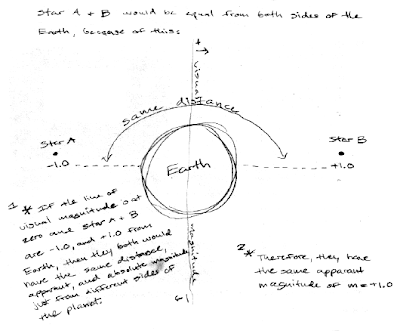
No comments:
Post a Comment